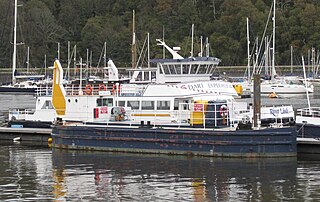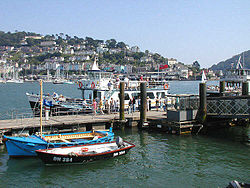
Dartmouth is a town and civil parish in the English county of Devon. It is a tourist destination set on the western bank of the estuary of the River Dart, which is a long narrow tidal ria that runs inland as far as Totnes. It lies within the South Devon Area of Outstanding Natural Beauty and South Hams district, and had a population of 5,512 in 2001, reducing to 5,064 at the 2011 census. There are two electoral wards in the Dartmouth area. Their combined population at the above census was 6,822.

The River Dart is a river in Devon, England which rises high on Dartmoor, and releases to the sea at Dartmouth.

South Hams is a local government district on the south coast of Devon, England. Services divide between those provided by its own Council headquartered in Totnes, and those provided by Devon County Council headquartered in the city of Exeter.

PS Kingswear Castle is a steamship. She is a coal-fired river paddle steamer, dating from 1924 with engines from 1904. After running summer excursions on the River Medway and the Thames for many years she returned to the River Dart in Devon in December 2012 to run excursions from 2013 onwards on the river she was built on and for. Kingswear Castle is listed as part of the National Historic Fleet of ships of "Pre-eminent National Significance".

The Dartmouth Steam Railway, formerly known as the Paignton and Dartmouth Steam Railway, is a 6.7-mile (10.8 km) heritage railway on the former Great Western Railway branch line between Paignton and Kingswear in Devon, England. Much of the railway's business is from summer tourists from the resorts of Torbay, who travel to Kingswear, where the Dartmouth Passenger Ferry takes them across the River Dart to Dartmouth.

Kingswear is a village and civil parish in the South Hams area of the English county of Devon. The village is located on the east bank of the tidal River Dart, close to the river's mouth and opposite the small town of Dartmouth. It lies within the South Devon Area of Outstanding Natural Beauty, and has a population of 1,332, reducing to 1,217 at the 2011 census.

Kingswear Castle is an artillery fort, built to protect Dartmouth harbour in Devon, England. It was constructed between 1491 and 1502 in response to the threat of French attack and was one of the first purpose-built artillery forts in Britain. By the end of the 16th century, however, improvements in the range of artillery weapons had reduced the utility of the castle. It took part in the English Civil War and continued to be armed until the early 18th century, but fell into ruin. Restored as a summer house in 1855, in the 21st century it is managed by the Landmark Trust as a holiday let.

Bayard's Cove Fort, also known historically as Berescove or Bearscore Castle, is an English 16th-century artillery blockhouse, built to defend the harbour entrance at Dartmouth in Devon. Constructed in the early part of the century, it had eleven gunports for heavy artillery and was intended to engage enemy vessels that broke past the external defences of the Dartmouth and Kingswear castles. It remained armed during the English Civil War, but was neglected in the 18th century and used for storage. The fort was restored in the late 19th century and is now managed by English Heritage and open to visitors.

River Link is a ferry, cruise boat, and bus operator, based in Devon, England. The company is owned by Dart Valley Railway plc, who also own and operate the Dartmouth Steam Railway.

The MV Cardiff Castle is a twin screw passenger vessel, operating on the River Dart in South Devon, UK, mainly on the cruise / ferry route between Dartmouth and Totnes, but also on circular cruises from Dartmouth, for Dart Pleasure Craft Ltd.
G.H. Riddalls and Sons was a passenger boat operator on the River Dart, in South Devon, England. It operated on the route from Dartmouth to Totnes, on circular cruises from Dartmouth and also ran the ferry service from Dartmouth to Dittisham. The boats were painted with red hulls and white superstructures, and were marketed as the "Red Cruisers".

The MV Dartmouth Princess is a single screw passenger vessel, operating on the River Dart in South Devon, United Kingdom. She is mainly used on the Dartmouth Passenger Ferry service from Dartmouth to Kingswear, where she runs year-round as the main vessel.
The MV Edgecumbe Belle is a single screw passenger vessel, operating from Mt Edgcumbe and Stonehouse Plymouth running 7 days a week half hour service also carrys Marley the ferry dog.

The MV Lady Wakefield is a twin screw passenger vessel, operating between Glenridding, Howtown and Pooley Bridge on Ullswater in the Lake District for Ullswater Navigation and Transit Co, marketed as Ullswater 'Steamers'.
MVSeymour Castle is a river boat sailing for Thames River Cruises of Reading, England as the MV Devon Belle. She is registered by National Historic Ships on the National Register of Historic Vessels, certificate number 1955, and is one of the surviving "Little ships of Dunkirk" from the Dunkirk evacuation in 1940.
The River Dart Steamboat Co Ltd (RDSC) and its predecessors, the Dartmouth Steam Packet Company and the Dartmouth and Torbay Steam Packet Company, were the major ferry and excursion boat operators on the River Dart in South Devon for 120 years, until the company's demise in 1976. The company was famous for its distinctive paddle steamers, which were a familiar sight on the river until the late 1960s.

MV Devonair Belle was the original name of the MV Dart Explorer, which is a twin-screw passenger catamaran, operating on the River Dart in South Devon, UK, mainly on the circular harbour cruise route from Dartmouth, for Dart Pleasure Craft Ltd.

MV Dartmouth Castle is a passenger ship operating on the River Dart for the Dartmouth Steam Railway and River Boat Company. She is listed on the National Register of Historic Ships

Dart Lifeboat Station is the base for Royal National Lifeboat Institution (RNLI) search and rescue operations at Dartmouth, Devon in England. The present station was opened in 2007 although an earlier lifeboat was stationed in the town from 1878 to 1896. It operates a D class (IB1) inshore lifeboat (ILB).

NCI Froward Point is a busy National Coastwatch Institution (NCI) lookout station at Inner Froward Point at the easterly side of the mouth of the River Dart two miles by coast path from Kingswear in Devon in England. Its twin duties are to maintain an hours of daylight watch over the local coastal area and the South West Coast Path on whose route it lies. With some significant blind spots because of the coastline, NCI Froward Point covers the coastline from Start Point in the West towards Brixham in the East.
























